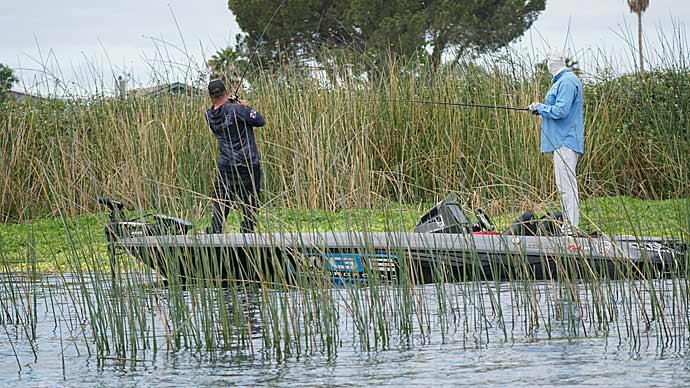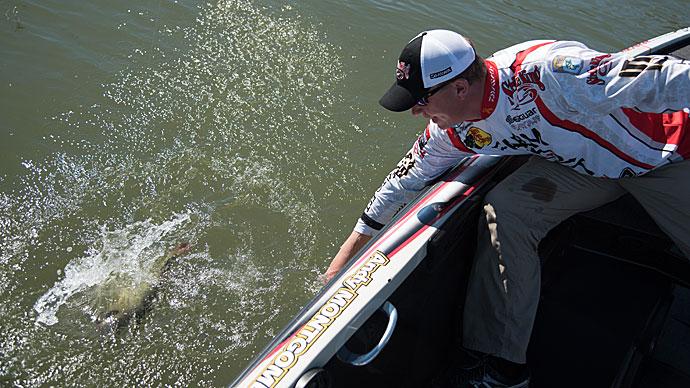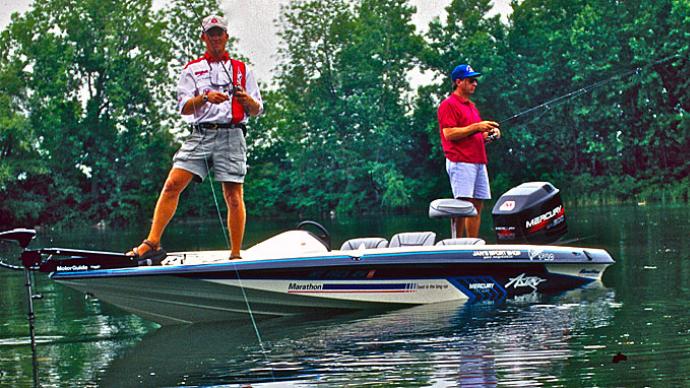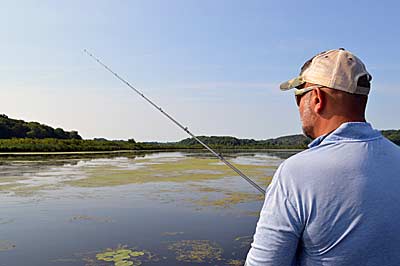
Summer’s dog days are when bass fishing rolls over for many anglers. It’s hot and humid. The water churns with pleasure craft. And retrieving overweight offerings on deep-water offshore spots is no longer fun. But if your favorite fishing hole has aquatic vegetation, you need to sit up and take notice of one pattern — matted grass.
Many bass fisheries thrive because of aquatic vegetation. It helps keep water quality in check and sustains plentiful populations of bass prey—baitfish, crawfish, and insects. It also provides sanctuary for bass at each stage of their lives, from nursery to ambush point.
Aquatic vegetation is divided into two categories — emergent and submergent. The former is rooted underwater but grows above the water. Tulles, which reach for the sky, are a prime example. Some naturally mat on the surface, including lily pads, invasive water chestnut and duckweed. Even algae gobs form mats in some places.
Submergent vegetation grows underwater and includes milfoil, hydrilla, and coontail. Many of these varieties can mat on the surface under certain conditions, including an early spring, which gives them more time to grow and top out, and a dry summer, when lower water levels put them closer to the surface. Or it may be as simple as them growing in shallow water.
Sometimes mats are shaped by human hands: Pieces of submerged vegetation are cut, usually by propellors or harvesters, float, and collect in small shoreline pockets or corners of docks or boathouses. Regardless of how mats form, they hold bass from late summer through early fall, when water levels fall far enough to rob these spots of depth or the first cold weather kills the shallowest growth.
Mats are where some of late summer’s biggest hawgs wallow and create heart-stopping strikes, whether solid thumps or explosive blowups. But wrestling more of them from cover thick enough to choke a 36-volt trolling motor, cancel casting presentations, and shellac “snagless” lures requires a particular approach. Here’s how to do it.
Quantity Counts
Image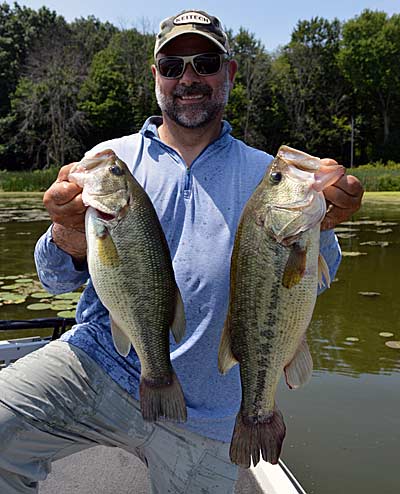
Big bass wallow in matted aquatic vegetation throughout August and well into September in most places. Plenty of protective cover and prey are the biggest attractions. Photo by Pete M. Anderson Not all mats are equal. The best ones share a characteristic — thickness. More vegetation means more shelter, giving bass plenty of hiding places. It also supports more prey, a vital characteristic of any productive spot.
The best mats have between 75% and almost 100% surface coverage. Some open water — down to holes the size of a cocktail napkin — is important. They give your lure access underneath the mat. While a heavily weighted lure, for example, can crash through a solid mat if you give it a running start by first flipping it upward, a bit of open water makes it easier. It also gives bass access to lures scooting across the top of the mat; they often follow, striking where the mat meets open water.
Even though they look impenetrable from above, most mats are relatively open underneath. Think of it like walking through a forest. Leaves create a thick canopy above, but there’s room for you to roam around the trunks below.
Check Quality
You can judge a mat by its size. Some of the largest, which cover several acres, are home to limits of bass. But size isn’t the be-all and end-all indicator. Small mats, such as those that form in inside corners of docks, are outstanding producers; you may only catch one bass off each, but they are usually big. To get a complete sense of a mat’s productivity, you must consider its quality, too. And the best are comprised of vegetation that’s green and clean.
Green aquatic vegetation is alive, growing and adding oxygen to the water instead of robbing the life-giving component as it decays. So naturally, bass prefer it. They also are drawn to vegetation that isn’t slimed with algae. But don’t immediately abandon mats that have algae-covered grass. While even a little makes fishing more difficult by fouling your lure, bass work on a sliding scale. They’ll deal with some, especially if the mat is the best available shallow-water cover. And sometimes, that algae only clings to the top of the plant, so it’s clear swimming below.
Look Deeper
Most matted grass looks the same from above. But if you dive under them, you'll discover plenty of differences, not only between mats but within the same one. Most are associated with the bottom. Bass gravitate toward these differences, so you should, too. Look for these:
- Bottom type: Most aquatic vegetation grows best in a soft substrate. But bass prefer harder types such as sand or gravel. The edge where they meet gives a spot more complexity, which bass favor.
- Depth change: Most mats grow on flats, which have consistent depth. Changes in that, such as depressions or channels, attract bass. They also provide cover, whether from changing conditions or ambushing prey.
- Additional cover: More is better when identifying a productive mat. Watch for additional cover types, such as logs and rocks—even an old tire on the bottom warrants more of your flips.
Finding these differences requires some detective work. You can’t roll up to a mat and scan it with your electronics, so you must watch for visual clues. Bottom content, for example, causes aquatic vegetation to grow differently. It thins as the bottom goes from muck to sand or gravel, for example, changing from thick beds to isolated clumps.
Conditions Count
Any day is a good day to go fishing, but some are better. That axiom applies to fishing matted vegetation, too. And while you’ll almost always find a bass or two swimming under and around it, certain days bring more bites.
- Water: More light passes through clear water than muddy water. The former encourages more aquatic growth and pushes bass into the heavy cover, making locating them easier. Muddy water, which can be caused by strong winds or heavy boat traffic, doesn’t do either, shutting down this bite.
- Wind: While a bit of breeze can blow your pitches off target and stop you from seeing through the rippled surface, it can help. If you’re trying to cover an expansive mat, pull your trolling motor and raise your outboard, letting it push your boat across. Drop your shallow-water anchors or a waypoint when you catch one so you can exploit any school that swims there.
- Sky: Fishing matted aquatic vegetation is best under bright skies, which push bass further into and tighter to heavy cover. That makes them easier to target because you have a better idea of their location. Bass find more comfort and become more aggressive in low light conditions, straying further from heavy cover under overcast skies or early or late in the day.
Pick The Best Lures
Image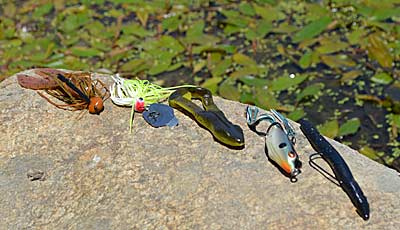
hen it comes to presentations for matted aquatic vegetation, you have three choices — around, over, or into. So, rig lures that do one of those, including bladed jigs, frogs and toads, jigs, and Texas-rigged soft-plastic worms. Photo by Pete M. Anderson Matted aquatic vegetation gives you three choices when presenting a lure — around, over, and into. Bass will bite in any of these directions. Prepare for each by bringing these four lure types:
- Bladed jig: If the water is stained, surface rippled, or sky cloudy, bass move toward a mat’s edges, where they can be picked off with one of these fast-moving lures. Its violent shaking action, which can be augmented with a swimming trailer, draws bass from a distance, making it efficient. And it runs anywhere in the water column; let it sink or slow your retrieve if you need to fish deeper. You could substitute a spinnerbait, but these work better without a large frame and spinning blades.
- Frog and toad: Bring both to feel fully prepared. A hollow-bodied frog works best over the thickest mats. Be prepared for explosive strikes anytime, especially when it nears a hole or the edge. Pick a color that’s easy for you to see — when it disappears, set the hook — because bass are attracted to the action. Soft-plastic toads, which act like a finesse buzzbait, need some open water to get their legs kicking, though they still draw strikes when dragged like a frog.
- Soft-plastic worm: Texas rigging makes plenty of soft-plastic lures work in matted aquatic vegetation. But none, with maybe the exception of a tube, work better here than a straight-tail worm such as Zoom’s Trick Worm or Yamamoto’s Senko. Unlike others with ribbon tails or flappy appendages, there’s nothing to wrap around vegetation, killing presentations by preventing the bait from getting to the bottom. Add enough weight, and these will slither straight through.
- Jig: This bait works similarly to a soft plastic worm. But there will be days when bass prefer its compact profile. Choose one that weighs at least ½ ounce, ensuring it bullies its way through the mat. It should have a rattle to draw bass and a stout hook to extract them. As with soft-plastic worms, choose a trailer with flappy, not twisty, legs. They’re less likely to hang and continue creating a waving action when your jig rests on the bottom.
Whichever lure you use, don’t skimp on your gear. Even small bass are tough in matted aquatic vegetation, where you must move both to land your catch. A big rod, stout reel, and strong line keep pressure on bass while you get them up and out. Here’s what you’ll want:
- 7- to 8-foot rod: Its fast action and heavy power work together. First, they create pinpoint flipping and pitching presentations, which are important for slipping your lure into the smallest openings. Second, they generate enough leverage, allowing you to pull bass up and out of thick vegetation.
- High-speed reel: With at least a 7:1 gear ratio, it grabs feet of line with each handle turn. That keeps pressure on bass, which often tangle in the vegetation, using it as leverage to twist off the hook. It also adds presentations to every fishing day by quickly retrieving errant ones so you can make better ones sooner.
- 50- to 65-pound test braided line: It's strong and abrasion-resistant, taking any abuse sent its way. It lacks stretch, making it super sensitive, so you’re always in contact with your lure. And its relatively thin diameter saws through grass, helping you land more bass.


